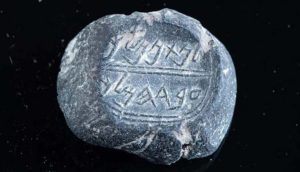
Once again, the archaeological find of yet another unearthed artifact not only supports Jerusalem to be an ancient Jewish city, it corroborate the accounts written in the Holy Bible.
By David Lazarus
A Rare and Exciting Discovery: A 2,600-year-old seal with impression bearing the words: “belongs to Nathan-Melech, Servant of the King.”
The Israel Antiquities Authority (IAA) reports that the seal was excavated in the City of David along the south-eastern slopes of the Temple Mount and is dated to the First Temple period.
The name Nathan-Melech appears only once in the Bible, in II Kings 23:11, where he is described as an official in the court of King Josiah, who participated in a cleansing of the Temple precincts that King Josiah initiated. “And he took away the horses that the kings of Judah had given to the sun, at the entrance of the house of the Lord, by the chamber of Nathan-Melech the officer, which was in the precincts; and he burned the chariots of the sun with fire.”

The bulla “(belonging) to Nathan-Melech, Servant of the King,” discovered March 31st, 2019. – Photo: ELIYAHU YANAI of the CITY OF DAVID
The title “Servant of the King” (Eved HaMelech) appears often in the Bible and describes a high-ranking official close to Israel’s kings. Dr. Anat Mendel-Geberovich of the IAA notes that the fact that this official was mentioned by his first name alone indicates that he was known to all, and there was no need to add his family lineage.
The seal was discovered inside an important public building that was destroyed at the same time as the destruction of the First Temple built by King Solomon. According to Prof. Yuval Gadot of Tel Aviv University and Dr. Yiftah Shalev of the Israel Antiquities Authority who were responsible for the dig, the building where the seal and other artifacts were found was destroyed in the sixth century BCE – likely during the Babylonian destruction of Jerusalem in 586 BCE.
Large stone debris, burnt wooden beams and numerous charred pottery shards were discovered in the building, all indications that they had survived an immense fire. The importance of this building can be seen, among other things, from its size, the finely-cut decorative stones from which it was built, and the quality of the architectural elements found, including remnants of a polished plaster floor.

Dr. Anat Mendel Geberovich of the Israel Antiquities Authority
The seal impression that was uncovered was deciphered by Dr. Mendel-Geberovich, who, according to the script, also dates it to the middle of the seventh century to the beginning of the sixth century BCE.
“Although it is not possible to determine with complete certainty that the Nathan-Melech who is mentioned in the Bible was in fact the owner of the stamp, it is impossible to ignore some of the details that like them together,” Mendel-Geberovich said in the IAA announcement.
These kinds of seals were used to sign documents and were often set into signet rings worn by their owners. In biblical times these stamps noted the identity, lineage and status of their owners. In this case, the servant of the king.
View original Israel Today publication at:
http://www.israeltoday.co.il/NewsItem/tabid/178/nid/36326/Default.aspx







 Israeli New Shekel Exchange Rate
Israeli New Shekel Exchange Rate